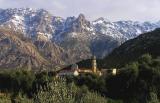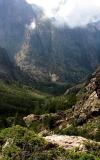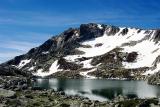GR 20 - the toughest long distance trail in Europe
GR 20 is a long distance trail that traverses Corsica diagonally from north to south. It's 180km long with variation in height of about 10 000 metres and can be walked in 15 days. Even though the GR20 doesn't require any climbing techniques, perfect fitness level and confidence in walking over a variety of rugged terrains is necessary.
Route planning
The trail consists of two parts:
- The northern part starts in Calenzana and stops in Vizzavona. It is the most difficult part, because of the steep and rocky paths, but it is also considered more beautiful.
- The southern part goes from Vizzavona to Conca and is easier, but less spectacular, except the Coscione plateau with its green meadows.
You can walk in either direction through the whole trail or any of the two sections only. Because the GR 20 is quite overcrowded and most hikers walk southwards, some people recommend walking northwards, to limit the meetings of crowds to short periods only.
Map of the GR 20 route
The map below shows the basic GR 20 route in green with red numbered markers indicating the starting/ending points of usual daily stages. Grey lines show another long-distance trails that cross the GR20: Tra Mare e Monti in the North near Calenzana, Mare a Mare Nord in Col de Vergio (8) and Mare a Mare Centre in Col de Laparo near refuge d'Usciolu (16).
Daily stages
- Calenzana
- Refuge d'Ortu di u Piobbu
- Refuge de Carrozzu
- Refuge d'Asco Stagnu (Haut Asco)
- Refuge de Tighjettu
- Bergeries de Ballone (alternative to Tighjettu)
- Refuge de Ciottulu di i Mori
- Castellu di Verghio (alternative to Ciottulu di i Mori)
- Refuge de Manganu
- Refuge de Pietra Piana
- Refuge de l'Onda
- Vizzavona
- Bergeries de Capannelle
- Col de Verde (alternative to Prati)
- Refuge de Prati
- Refuge d'Usciolu
- Refuge d'Asinao
- Col de Bavella (alternative to Paliri)
- Refuge de Paliri
- Conca
Note: For the best online map of Corsica go to GeoPortail.fr, click on "Corse" on its home page, then select "Carte" left of the map and zoom to the ratio scale of at least 1:13000, where major hiking trails are mapped in purple and even contour lines are displayed.
Itinerary
The following table lists all daily stages of the GR 20 route. Click on the links to see more information about a particular stage and its detailed map including variants, side trips and escape routes.
(Source of altitudes and walking times: Parc naturel régional de Corse)
Getting there and out
Calenzana, the northern starting point, is located near Calvi and is well accessible from the Sainte Catherine Aeroport. You can go to or from Calvi by a ferry too and then use a bus route Calvi Calenzana. Going from Bastia, you can get to Calvi either by bus (one connection a day except Sundays, duration 2 hours), or by train (two or three connections a day, duration 2h44). See the bus Bastia-Clavi timetable or look up the train from Bastia to Calvi.
Conca at the southern end of GR 20 is located near Porto Vecchio, connected via ferries with Marseille and Livorno, and near Figari airport. Bus routes connect Porto Vecchio with Conca and Porto Vecchio with Bastia. There is a railway station in Vizzavona with trains going to and from Bastia and Ajaccio, as well as the bus route Ajacio - Corte - Bastia. Learn more about Corsican airports or how to get to or from Corsica by ferry or by air.
Alternate entry and exit points
Besides the main entry points in Calenzana, Vizzavona and Conca there are a couple of another places where you can get on or off the GR 20 trail:
- Bonifatu - Refuge de Carozzu. There is a road from Calenzana to Maison Forestiere de Bonifatto and even a little further to Cirque de Bonifatu, where it joins the alternate route between refuges Piobbu and Carozzu. See stage 1 for a detailed map.
- Asco Stagnu (Haut-Asco) in the 3rd stage is reachable by car via D147 road from Ponte Leccia across Asco. Haut Asco is a popular ski resort and the trail head for climbing Monte Cinto, the highest peak in Corsica, so you can try hitch-hiking to or from there. There is also a bus line between Ponte Leccia and Asco.
- Col de Verghio is a mountain pass on the D84 road from Corte to Porto (via Albertacce and Evisa) with a decent traffic. For details see the map of the 5th stage. A seasonal bus line from Corte to Porto crosses the Vergio Pass.
- A footpath through the Tavignano Valley goes from Corte to Lac de Nino in the 6th stage.
- Another path from Corte goes through Restonica Valley and joins the GR 20 above Lac de Melo in the 7th stage. A bus goes from Corte to the Bergeries de Grutelle approx. hourly in summer.
- Refuge de Manganu in the 6th stage can be reached via foothpath going across Lac de Creno from the villages of Soccia and Orto.
- Another foothpath connects Refuge de Pietra Piana in the 7th stage with the village of Guagno.
- Bergerie de Capannelle in the 10th stage is at the end of the road from Ghisoni but there isn't a lot of traffic there.
- Col de Verde (stage 11) is located on the D69 road from Ghisoni to Cozzano. Traffic is quite low there.
- D268 road from Ajaccio to the east coast crosses the GR20 at Col de Bavella (stage 14). Traffic is high enough there to rely on hitch-hiking.
When to go
The best time for the GR20 trek is late June and early September, when most huts are open, weather is not so hot and the trail is less crowded than in July or August. Between November and May there is snow in the mountains and the trail is quite dangerous. There are no guards in refuges off-season, so you have to carry all food.
In winter (February to April), the GR 20 can be only crossed by experienced cross-country skiers with a high mountain guide. The winter variant of the GR20's northern part is known as l'Alta Strada.
Lodging and food
Mountain huts (refuges) along the GR 20 offer basic accommodation and food. Refuges, where can sleep 25-50 people (see details of the particular stages), have usually one large dormitory with long wooden bunks that are equipped with thick mattresses. Sleeping in tent nearby the refuges is possible, on other places along the trail it is not permitted. Taking a tent is a good idea as you cannot always guarantee that you can get into a refuge.
Refuges are run by Parc naturel régional de Corse (PNRC). Prices as of June 2009 are 10 € per bed in a hut and 5 € per person camping. Additionally there are a couple of private bergeries, gites and hotels along the trail that are generally more comfortable and more expensive (see stages).
Refuges are the only places where you can buy food and get drinking water along the trail. In some stages you can go shopping to the villages below the mountains (Calasima or Albertace in the 5th stage, Soccia in the 6th stage etc.).
All the above apply to the season from June to September only. Although the PNRC refuges stay open all year round for safety, don't expect food, drinking water, heat and light in them between November and May.
Path marks
The trail is well marked with red and white rectangles on rocks, boulders and trees. Feeder paths are marked with one colour. There are also small stone heaps along the path. It's still easy to get on a feeder path or to lose the way, so having a good map is necessary.
Highlights of the trail
- Cirque de la Solitude -- a steep and challenging part of the 4th stage, where hikers have to climb using the chains bolted to the rock.
- Lac de Nino -- a glacial lake in the middle of the grassy meadows in the 6th stage.
- Lac de Melo and Lac de Capitello -- two another glacial lakes surrounded by rugged rocks in the 8th stage.
- Monte d'Oro -- the 12th highest summit of Corsica in the alpine variant of the 9th stage.
- Monte Incudine (2134 m) -- the highest mountain of Corse du Sud (Southern Corsica) with great vistas of Plateau de Coscione in the 13th stage.
- Aiguilles de Bavella -- a spectacular cliffs in the 14th stage.
Possible side trips
- Monte Corona -- ascent to the 2144 m high summit at the end of the 1st stage (or the beginning of the 2nd stage).
- Cirque de Bonifatu -- a little less scenic yet more shady variant of the 2nd stage.
- Monte Cinto -- ascent to the highest summit of Corsica (2706 m) at the end of the 3rd stage.
- Paglia Orba -- ascent to the 7th highest (and the most beautiful according to many people) peak of Corsica (2525 m) in the 5th stage (climbing skills are necessary).
- Lac de Creno -- descent to the beautiful lake in the 6th stage.
- Monte Rotondo (Monte Ritondu) -- ascent to the 2nd highest summit of Corsica (2622 m) in the 7th stage.
- Monte Renoso -- ascent to the 2352 m high summit above the glacial lake of Bastiani (2089 m) in the 11th stage.
Video
You can admire beauty of the GR 20 in this fantastic 55-minute documentary video filmed by Michele, who was so kind and posted it to our forum. He did the Northern part of the trek in July 2010.
Corsica GR20 North: Memories of a trekker (English version) from RedAlert on Vimeo.
GPS files for download
If you use a GSP handheld device (Garmin, Magelan etc.), you can download the following tracks in GPX format:
- gr20-nord.gpx (96 kB) - the northern part of the GR 20 trail from Calenzana to Vizzavona, including variants (Cirque de Bonifatu, Monte d'Oro, Canaglia) and side trips (Monte Cinto, Calasima, Lac de Creno). No named way points included.
- gr20-sud.gpx (69 kB) - the southern part of the GR 20 trail from Vizzavona to Conca, including alpine variant across the Aiguilles de Bavella. No named way points included.
- gr20-all-wp.gpx (29 kB) - all named places, both the waypoints on the track and the points of interest along the route.
- gr20-all.gpx (191 kB) - the three files above merged into one.
Note: You are welcome to link to the files using this link. Please don't link to the files directly, because their name and location could vary. Read more details on GR20's GPS data in my blog.
GR 20 name's origin
GR stands for Grande Randonnée, which means big excursion in French. It is a network of long-distance footpaths in Europe, mostly in France, Belgium, the Netherlands and Spain. GR20 is considered to be the most difficult of all the GR routes. Its Corsican name is Fra li monti (sometimes spelled wrong as Fra li monte), what means "across the mountains" in Corsican.
GR 20 discussion
Ask a question or share your personal experience related to the GR 20 trail in our GR20 discussion forum. Please, don't ask questions in the comments below on this page. Comments are provided just as a feed back for the page's author and may be deleted after some time.
Additional resources on the GR 20 trail
- GR 20 on the Parc naturel régional de Corse official website -- official info, advices, stages' description and contacts of regional authority (in French)
- GR20: Corsica, The High Level Route -- an excellent guide book by Paddy Dillon and published by Cicerone. Another interesting one is Walking on Corsica, Long-distance and short walks by Gillian Price.
Photos of the GR 20 trail
Last modified on Sun, 2013-04-28 18:47



